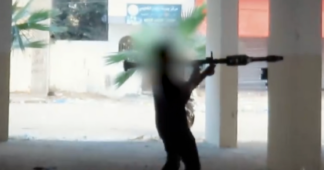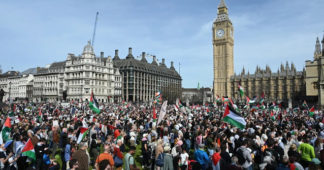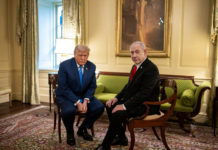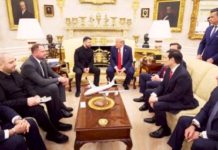Robert Inlakesh
SEP 22, 2025
Washington’s subsidized bulldozer shipments are enabling Tel Aviv to raze Gaza to the ground, reviving tactics used during the Nakba to ethnically cleanse Palestine.
In recent months, Israel has ramped up its use of heavily-armored bulldozers to raze entire neighborhoods, olive groves, and critical infrastructure across the already devastated Gaza Strip. These machines form part of a systematic strategy to permanently alter Gaza’s geography and demography.
In January, US President Donald Trump greenlit the transfer of 134 D9 bulldozers to Israel, upon the implementation of the Gaza–Israel ceasefire agreement. This massive deal had previously been frozen under former US president Joe Biden’s administration. The US-made Caterpillar machines, dubbed “Doobi” or “Teddy Bear” in Hebrew, were swiftly put to use after Israel violated and ended the ceasefire. Soon after, “Operation Gideon’s Chariots” was launched on 16 May, flattening over 2,100 buildings in Khan Yunis alone, shortly after the deal was finalized.
US bulldozers powering Israel’s war machine
In July, Israel received a shipment of bulldozers from the US, in what has been described as “the largest air-and-sea logistics operation in the history of the State of Israel,” according to a Defense Ministry official. Back in February, Tel Aviv also requested another military purchase of brand-new bulldozers, estimated to cost a total of $295 million. In March, the US then fast-tracked the deal, managing to bypass congressional approval by doing so.
Many of these machines have since been deployed to expand Israel’s so-called buffer zone in Gaza, now stretching more than one kilometer into the coastal enclave, severing the strip from the rest of occupied Palestine. There, Israel’s combat engineering corps – which includes the Yahalom, Asaf, and Lahav battalions – have been used to both bulldoze and rig buildings with explosives, also destroying the majority of Gaza’s agricultural lands. According to UN estimates, 92 percent of Gaza’s residential structures have been either partially or completely destroyed.
With the Israeli army overstretched and short on manpower, the Israeli Defense Ministry has enlisted private contractors to drive the demolition effort. Ads offering up to $882 a day have circulated on social media, while investigative reports from Haaretz reveal the operation now includes more than 500 heavy engineering vehicles, racking up costs of nearly $30 million per month.
A destructive legacy
Immediately following Operation Al-Aqsa Flood on 7 October 2023, Israel began halting exports of military equipment and tanks, announcing instead its purchase of dozens of bulldozers. This move came as an effort to reinforce their armored units. The Israeli bulldozer strategy finds its origins in the Ethnic Cleansing of Palestine (1947-1949), during the Nakba (The Catastrophe), where Zionist militia forces not only expelled some 750,000 people from their homes, but demolished over 400 villages as a form of erasing their connection to the land.
The Caterpillar D9 – first acquired by Israel shortly after its release in 1954 – has since become a staple of the Israeli army’s arsenal. There have been numerous modifications added to it, leading to the D9L, D9N, D9R, and D9T, which are all deployed by Israel today. These vehicles are then sold to Israel by the American company as civilian bulldozers, despite often being part of US military packages, and are subsidized by American tax dollars.
When the CAT D9s arrive, they are quickly fitted with Israeli-developed armor, parts, and weaponry. The Israel Aerospace Industries (IAI) weapons company is primarily responsible for converting the bulldozers for military purposes. Even Israeli universities have been involved in the D9 development project, as Technion University in Haifa was responsible for designing the first remote-controlled version of the D9 that is used in Gaza today.
Israel does not make public the number of D-9 bulldozers it currently has in operation. In fact, it actively works to obscure that knowledge from the public. Since acquiring the D9s in the 1950s, Israel has used them in every major conflict as key weapons of war, ranging from the 1956 Suez Crisis, through to the First and Second Intifadas, right up until today.
One of the largest purchases came in 2001 of 50 bulldozers, yet over the decades, bulldozer purchases were occasionally interrupted by legal challenges, such as the case brought by the family of Rachel Corrie – an American peace activist crushed to death by a D9 in 2003– but these were ultimately dismissed by US courts, and the deal was unfrozen. In 2017, Israeli outlet Walla News reported that 20 heavy engineering vehicles were purchased from Caterpillar, which it labelled “the largest of its kind in 20 years.” Despite the lack of an official policy, an investigative piece last month by Haaretz found that the military demolition campaign is being driven by commanders “on the ground”:
“This is an unprecedented engineering project, taking place despite neither the military having an official policy on the matter, nor the political leadership having made an official decision to demolish all of the homes in Gaza. In fact, this policy is coming from the forces on the ground, from company and battalion commanders, who are concerned that the buildings left standing endanger the lives of their troops.”
This mirrors the implementation of Plan Dalet during the Nakba, where orders to expel Palestinians were implicit, leaving execution up to field officers. Then, as now, the goal remains the same – to depopulate and reconfigure the land.
A nationwide demolition doctrine
Between 1967 and 2011, Israel destroyed at least 28,000 Palestinian homes, many of which were demolished with bulldozers and other heavy equipment. This does not even include the number of homes destroyed in Gaza during its major attacks on the territory, when bulldozers were also used, in 2012 and 2014. The bulldozer strategy is so entrenched in Israeli public consciousness that the late former prime minister and war criminal, Ariel Sharon, was often referred to as “The Bulldozer,” and the nickname for the D9s was originally “Pooh HaDov” (Winnie the Pooh), before evolving to become “Teddy Bear.”
While Gaza bears the brunt, this strategy is far from confined to the besieged coastal strip. In occupied East Jerusalem, settler groups exploit Israel’s 1950 Absentee Property Law to expropriate Palestinian homes, while the state denies building permits to justify demolitions. Since 1993, around 3,000 structures have been destroyed this way. Similarly, in the Negev, Israel has set up a system with the Bedouin towns in the area, whereby the majority of their villages are deemed “unrecognized.” These 14 villages are consistently bulldozed, despite the residents there holding Israeli citizenship.
In the occupied West Bank, Palestinian homes are demolished, due to punitive measures that were once banned but had returned as State policy in 2014. In essence, if you carry out an attack against an Israeli, your family home will be destroyed. Israeli officials and settler leaders openly invoke the Biblical language of ‘Judea and Samaria’ to frame this policy as divinely sanctioned, transforming collective punishment into a supposed religious duty. Beyond punitive demolitions, the Israeli army has also destroyed homes and orchards under the pretext of military zoning or permit violations, particularly in Area C. Refugee camps like Nour al-Shams and Jenin have seen entire communities uprooted by bulldozer assaults that cut off water, power, and roads. Similar tactics are now being applied in Syria’s Quneitra province and southern Lebanon, where the Israeli army seeks to create new “security zones” with the same machinery.
In all these areas, under different legal and security excuses, the goal is the same. Throughout the month of August alone, Israeli bulldozer drivers openly published dozens of videos bragging about demolishing thousands of olive trees and homes.
Western complicity and the machinery of ethnic cleansing
The D9 may be the poster child of this policy, but it is not alone. Excavators and engineering equipment from American, South Korean, and European firms have been used to build settlements and raze Palestinian land. Bulldozers used in the infamous mass demolition campaign against homes in the Masafer Yatta area of Al-Khalil (Hebron) were supplied by Volvo. The equipment of Volvo was even used in the construction of illegal settlements such as Har Gilo.
Hyundai Heavy Industries has also long provided track excavators and other machinery that have been used by the Israeli military and in the construction of illegal settlements. In 2017, Hyundai equipment was even used in the construction of a settler-only road in the occupied West Bank, a project which uprooted 700 olive trees.
Due to a lack of sufficient tanks and armoured personnel carriers, Israel has also been relying on AM General HMMWV Humvees to transport its forces and workers to carry out demolition work, recently placing an order for “hundreds” more of these vehicles. The US-based General Motors company also signed a deal back in 2022 to supply both vehicles and engines to the Israeli military.
The complicity of western corporations in the bulldozer doctrine allows a depleted Israeli military to sustain what all major human rights groups – including Israel’s own B’Tselem – have called genocide in Gaza. The policy binds Israeli society itself to the machinery of dispossession, drawing in civilian firms, contractors, and workers into the architecture of ethnic cleansing. In this way, today’s bulldozer campaign revives the very same strategy of erasure first unleashed during the Nakba.
We remind our readers that publication of articles on our site does not mean that we agree with what is written. Our policy is to publish anything which we consider of interest, so as to assist our readers in forming their opinions. Sometimes we even publish articles with which we totally disagree, since we believe it is important for our readers to be informed on as wide a spectrum of views as possible.











